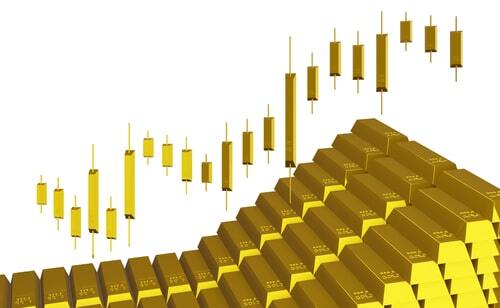
Can gold price tackle $2,000 next week? Here's how that can happen
After another solid week of gains, gold could be ready to take on the $2,000 an ounce level next week. But there are a few technical elements that need to come together for that to happen.
Gold was able to advance more than 1.3% on the week despite a massive surge in U.S. Treasury yields, triggered by markets betting on a more aggressive Federal Reserve. This comes after Fed Chair Jerome Powell signaled a possibility of 50-basis-point hikes at upcoming meetings in May and June.
On Friday, the 10-year rate jumped, hitting 2.503% on Friday — the highest level since May 2019. And April Comex gold futures were last at $1,957.00.
"Higher yields are typically negative for non-interest bearing gold, but for now, the ongoing divergence between the two asset classes highlights the market's newfound sensitivity to inflation and the need to buy any/all real assets (including gold) as a hedge," said MKS PAMP head of Metals Strategy Nicky Shiels.
There is also a growing concern that the yield curve will invert. The relationship analysts pay close attention to is the 2-year and 10-year Treasury yields.
"Typically, when you see an inversion of the yield curve, it projects a strong possibility of some kind of a recession further out. Markets are expecting to see weakness in the next two quarters. We already had one of the worst Januaries on record for equities. And gold has been making higher lows and higher highs. And it could push back up to $2,000," said Blue Line Futures chief market strategist Phillip Streible.
'Nothing but a series of black swan events' since mid-2019, what shock is next? Goehring & Rozencwajg weighs in
Inversion of the yield curve happens when long-term debt instruments have a lower yield than short-term debt instruments. And markets use this gauge to sometimes foreshadow a recession.
"We know that the yields curve is beginning to flatten. Rates continue to move higher. So far, there is no indication that the Fed is going to back off on rates. The market is talking about half-a-point moves at the next two meetings," RJO Futures senior market strategist Frank Cholly said.
There is a lot of debate around whether or not an inversion of the yield curve is a precursor to a recession. Still, the topic is definitely on everyone's minds as slower growth seems inevitable due to the Federal Reserve's aggressive monetary policy tightening.
"Once in a while, we'll see the curve starts to flatten. I am convinced yet that it is leading towards a recession. But I am concerned that the Fed may slam the brakes on growth a little too much if we do see continued rate hikes," Cholly told Kitco News.
However, markets might be pricing in too many rate hikes for this year, Streible pointed out. "The only thing the Fed can do is disappoint form here. It won't be able to raise rates in a weakening economic environment," he said.
The Fed is projecting seven rate hikes in 2022, but that number is likely to come down to five, Streible added.
For gold, this is a very constructive environment. "Gold is going to go higher next week. Gold is doing well against the yields. The number of rate hikes from here is limited. Rising yields are hitting their objectives at these levels. Gold should find some support," Streible told Kitco News.
And on top of the new safe-haven demand in light of the war in Ukraine, there is the inflation narrative that will continue to drive gold higher this spring.
The key level for gold to hit and sustain is the $1,957 an ounce, said Cholly. "I feel more bullish. Gold bounced up after hitting $1,900. We need to stay above $1,950. Once it is above $1,975, I start to feel encouraged again that we'll be above $2,000. We spent a week trading between $1,925-$1,950. The next level is $1,950-75 and then $2,000.”
Data to watch
Next week's two main data releases will be the U.S. Q4 GDP number and the employment report. Market projects see the GDP at 7.1% and for the U.S. economy to have added 488,000 jobs in March.
"The jobs numbers will be in focus, but while we know demand is incredibly strong, the issue is a lack of supply of workers to fill the vacancies available," said ING chief international economist James Knightley. "Like supply chain strains, a lack of suitable workers is holding back growth potential and putting up costs as wages get bid higher in a red hot jobs market."
Anything around 500,000 jobs for March would support expectations of a 50-basis-point rate hike in May, Knightley added.
Tuesday: CB Consumer Confidence
Wednesday: ADP nonfarm employment, GDP Q4
Thursday: Jobless claims, PCE price index
Friday: Nonfarm payrolls, ISM manufacturing PMI
By Anna Golubova
For Kitco News
Time to buy Gold and Silver on the dips
David